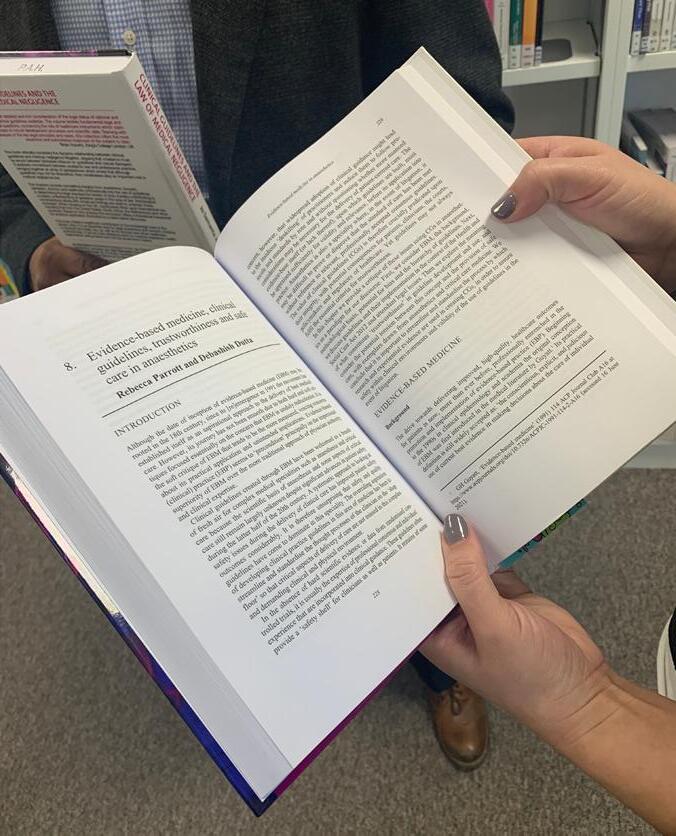
3 minute read
Consultant and library manager put pen to paper with new book
By Dr Dev Dutta, consultant
anaesthetist, and Becca Parrott, knowledge and library services lead
We are pleased to have put pen to paper and contributed to a newly published book.
The book, called Clinical Guidelines and the Law of Medical Negligence, is a detailed overview of the national and local clinical guidelines available for clinicians.
Edited by Jo Samanta, Emeritus Professor, Law School, De Montfort University,
this book chapter came after a time of working with Dr Dutta in our Intensive Care Unit (ICU), in the capacity of supporting evidence-based practice.
academic research around evidence-based medicine, methodologies and bias, the trustworthiness of publications, and the implementation of guidelines.
Leicester,
and
Ash
Samanta, Emeritus Consultant Physician and Rheumatologist,
University Hospitals of Leicester and Lecturer in Medical Law, Law School, also at De Montfort University, the book is an important resource for clinicians. We wrote the eighth chapter in the book, which focuses on evidence-based medicine, clinical guidelines, trustworthiness and safe care in anaesthetics.
Becca's experience
The opportunity to contribute to
I had just completed a Masters dissertation on the related topic of clinical librarianship, and how this role helps to bridge the gap between papers to patient: sourcing and applying evidence to enhance patient care. When Dr Dutta told me about a chapter he was writing for this new book, and asked if I would like to contribute; it was clear the topic was pertinent to our work together and also my own professional interests.
It was a timely opportunity that was too good to miss, as the chapter content was so relevant to my work:
Rather than sit down to write the chapter together, we each contributed sections that we wrote individually. These topics linked together, and drew on each of our interests and areas of knowledge or experience.
We initially discussed the topics we wanted to write about, and how these could flow together.
This gave us a good foundation for structuring our chapter and deciding which of us would cover particular sections. We also worked on the schedule and timings for the submission to our editors, and we had regular check-in meetings to discuss progress and ensure we were on track.
I have no immediate plans to write for publication at the moment, but my experience with writing this chapter has shown me that collaborations like this are valuable and achievable. As colleagues with shared professional interests, we all make up a body of information and experiences that can be utilised to share best practice and keep topics fresh and updated.
It was a pleasure to contribute to this excellent piece of work, and a welcome opportunity to encapsulate the collective outcomes of my professional practice as a healthcare librarian.

Dr Dutta's experience I first came into contact with Professor Jo Samanta while I was doing my law degree in Leicester. She was my supervisor and guided me in learning law and its applications. Professor Samanta had also signposted my journey through the dissertation I had to complete and had invited me to a couple of national debates after I completed my law degree.
One of the debates was regarding (a) available treatment options and funding procurement for neurological rehabilitation in patients with brain damage in the UK. The other national debate she invited me to was a joint conference with various medical experts of different clinical specialities, lawyers and barristers in London. This joint conference of national debate was based on any publication of clinical guidelines and the possible impact of those guidelines if applied in a court of law. It is after that debate that Professor Samanta approached me to write a chapter in the book she was planning to publish. I then approached and requested Becca to join me in writing the chapter. Becca and I decided to structure and include how the materials of medical evidence are explored and added to the guidelines. We also decided to include the source of the guidelines to be considered before embracing the clinical practice.
The blurb reads: “This book critically considers the dynamic relationship between clinical guidelines and medical negligence litigation, arguing that a balance must be struck between blinkered reliance on guidelines and casual disregard. It explores connections between academic law and professional practice, bringing together an array of perspectives which reveal that although guidelines may not be dispositive, they nonetheless play an important role in medical negligence law.
“The chapters provide compelling insights from academics, lawyers, barristers, doctors and healthcare professionals into the use of guidelines in determining the legal standard for breach of duty, thereby contributing to a holistic understanding of guideline usage in this area of law. Sociological considerations along with empirical findings are used to underpin these concepts.
“While focusing on the UK, contributors draw upon international law, including that from the United States, South Africa, the Netherlands and other countries. Based on this analysis, the conclusion offers a theoretical framework for practical application illustrated by a case-based discourse. This book makes a significant contribution to the knowledge base in the subject area. It is an essential read for legal academics and lawyers working in medical and health law, as well as for doctors and other healthcare professionals. It will be a key reference point for medical regulators, health organisation policymakers and clinical governance teams.”
You can find out more about the book here >
You can also contact us at dev. dutta@nhs.net and rebecca. parrott@nhs.net.









